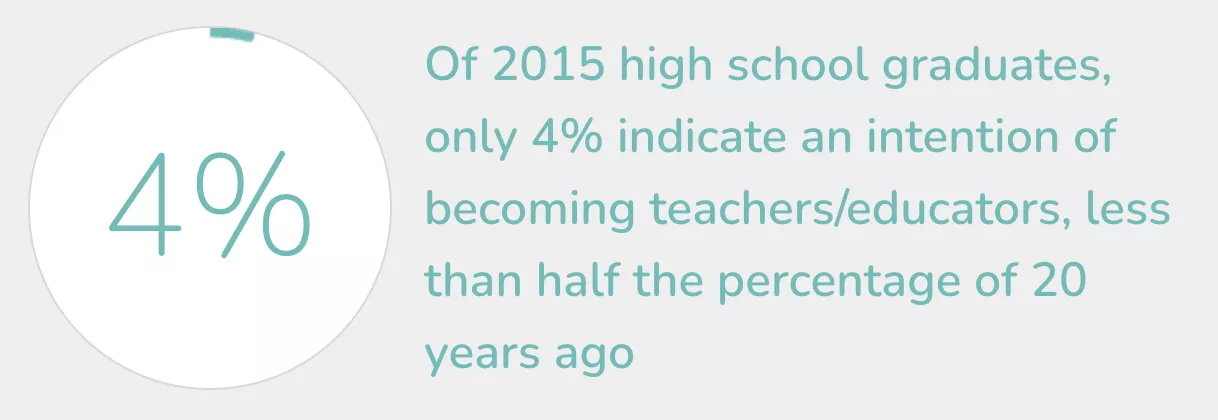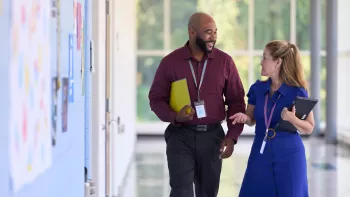How we define 'Potential Teachers'
Vision
The next generations of teachers must reflect the diversity of our society, and enrich our understanding of culture, race, and language diversity. PreK-12 students should be able to see their teachers as positive role models of varied races and backgrounds.
Potential teachers should be recruited based on previous academic achievements and/or potential for academic success and commitment to/potential for creating a culturally responsive learning environment for each student.
Recruitment efforts should target individuals who demonstrate openness to the broad range of cultures and show a potential for engaging in culturally responsive practices as an educator. After engaging in the significant demands of a TPP, they’ll be ready to enter the profession with a solid academic knowledge base, a mastery of the content they will teach, pedagogical understanding connecting theory and practice, understanding of their own culture and how it influences their perceptions, and the dispositions that will help them foster students’ growth and development.
Communities must show that they value the teaching profession. Educators should encourage their own PreK-12 students, as well as community members working in schools in non-teaching roles, to consider teaching as a career. Schools should hire people who chose education as their profession and demonstrate their commitment by investing the time and energy to develop the knowledge, skills and dispositions to being profession-ready.Recruiting must be a shared responsibility. PreK-12 schools, higher education partners, local teacher unions, and student program chapters should work together create programs that are grounded in sound design principles (such as those developed by Educators Rising in 2016), and help students experience the rewards of teaching, while developing a foundation of experiences prior to entering a TPP.
The Current Landscape
Educators Rising partnered with NEA and the National Board for Professional Teaching Standards (NBPTS) to create the Educators Rising Standards for programs to introduce PreK-12 students to the teaching profession.
TEACH Grants (Teacher Education Assistance for College and Higher Education) make it possible for prospective teachers to pursue a teaching career without amassing insurmountable college debt. The Government Accountability Office (GAO) offered recommendations to improve the efficacy of the program.
Preservice teachers generally enter TPPs with minimal cross-cultural experiences.
TPPs often engage in intentional recruitment at career fairs and college recruitment days at schools with diverse student populations as a strategy to increase the diversity of their teacher candidate population.
With teacher turnover still over 33 percent within the first three years in the profession (higher in many high-need schools), some schools/districts have turned to “grow-your-own” programs that seek to help paraprofessionals already working in the school to transition to a teaching career.

Some schools (usually high schools) offer courses introducing students to teaching as a career. These courses may be included within career and vocational programs in schools eligible for Carl D. Perkins funding. Colleges and universities also conduct recruiting activities that encourage students who are changing their majors or undecided to become future teachers.
Practitioners in the field identify other factors that discourage PreK-12 students from considering teaching as a career. Examples include:
-
Potential teachers recognize the great disparity among schools in terms of professional support and the quality of working conditions. School choice programs and similar public policies exacerbate the problem by inequitably distributing resources needed for student success to a subset of schools that only serve students who happen to come from the dominant race, live in an affluent ZIP code, or whose parent(s) decide to send them outside of their own community.
-
Students from disadvantaged schools often experience a tremendous opportunity gap leaving them far less prepared academically for postsecondary success in teacher preparation or other career choices.
-
Teacher shortages in key curricular areas also result in less prepared educators teaching in schools with greater diversity and higher poverty. Lack of adequate preparation, insufficient induction support, and challenging working conditions contribute to a high turnover rate for staff in these schools.
-
The staff “churn” in diverse and higher-poverty schools results in a lack of positive innovation and less engaging teaching strategies (Johnson, 2016). Students in these schools may fail to see teachers with the extensive experience and skills to teach in more culturally responsive ways.
-
Interest in education careers by high school seniors is at an all-time low. Only 4 percent of 2015 high school graduates, less than half the percentage from 20 years ago, indicate an intention of becoming teachers/educators.
-
The overall diversity of those entering TPPs remains relatively unchanged over the past 20 years.
-
Preservice teachers generally enter TPPs with minimal cross-cultural experiences.
-
There’s little proof that grow-your-own programs have been successful in producing significant numbers of new teachers.
-
Only limited partnerships between TPPs and PreK-12 schools to recruit future teachers are currently in place.
Transforming the Landscape
Cultivating a new generation of diverse, well-qualified teachers who are committed to career-long learning and professional growth requires targeting candidates (i.e., participants in a TPP) who believe in the worth and potential of each student, and the teachers’ role in giving students encouragement and direction. The 5 keys to transformation are a crucial part of both culture and actions during the recruiting phase of a teacher’s career.
Passion for Learning
Teachers with great enthusiasm and passion for learning show PreK-12 students that teaching is a career with tremendous intrinsic rewards. By engaging in culturally responsive practices, teachers also provide an accurate image to Pre-K students of what future educators need to know and be able to do, and crucial attitudes they should possess.
Teachers with great enthusiasm and passion for learning show PreK-12 students that teaching is a career with tremendous intrinsic rewards.
As more-experienced teachers engage students in deeper discussions of why they use particular strategies, they help students learn more effectively, giving insights into the nature of a teacher’s work. PreK-12 schools with such a positive environment help students transcend the notion that points, grades, and scores are the currency of success. Student learning — developing skills, and deepening understanding — are what teaching is all about.
Assessment for Excellence
Helping students prepare for college means more than focusing on preparation for standardized, norm-referenced tests. Schools must model performance-based assessment that’s free from bias and grounded in demonstrating mastery rather than earning points. Authentic projects contribute to learning and help to document meaningful student progress.
Schools must model performance-based assessment that’s free from bias and grounded in demonstrating mastery.
Culture of Collaboration
PreK-12 schools, TPPs, unions and their student programs must be partners in recruiting promising future teachers and in conveying to the recruits a spirit of confidence. These partners provide potential teacher candidates with academic supports and tools to navigate the path to admission into postsecondary education. These partners collaborate with their communities to create programs, courses, and experiences that allow potential teachers to gain a positive understanding of the teaching profession. They collaborate to develop successful grow-your-own programs to identify and support potential career changers who are likely to stay in the communities where they work.
Authentic Autonomy
PreK-12 schools motivate teachers by giving them greater autonomy over the design of teaching and learning strategies and by giving students greater autonomy over their academic goals and the authentic projects they choose on their learning journey. Programs that help students see their potential for a range of career opportunities allow them to choose teaching because it matches their values — their passion for learning and their commitment to help others find success.
Worth of Persons and Communities
Educators and communities convey to students that there is a pathway for them to career success through continued learning, regardless of the opportunity gaps they experienced or their personal economic challenges. This may mean a career in teaching. But, the doors of opportunity should be wide open, with a spirit of hope and realistic supports to help students in whatever career path they choose.
School improvement efforts focus on advocacy for adequate resources for schools and districts to overcome an opportunity gap for students and the lack of a challenging and comprehensive curriculum. Professional learning for current practitioners supports their efforts to model culturally responsive teaching and positive classroom management for potential teachers.
School leadership in schools serving economically disadvantaged students focus on creating the positive professional learning conditions that are likely to attract experienced professionals and encourage them to invest a lifetime of their career at the school and in the community.
Programs to develop potential teachers use Educators Rising standards as a design guide, focusing on culturally responsive teaching as well as a spirit of fairness, equity, and diversity as values that educators must embrace.
Practicing teachers see the dispositions of “teacher” in the lives of academically promising students and give them support and encouragement to pursue teaching as a noble calling to serve others. Communities understand and embrace their role in recruiting promising individuals into the profession. School districts and communities model high levels of professional, cultural, and emotional support for teachers during all career phases, particularly for aspiring teachers in training and emerging teachers beginning their careers.



